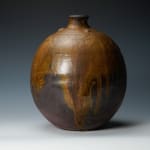Fujiwara Yu 藤原雄 1932-2001
Bizen jar
Stoneware
H10 5/8 × Dia 9 1/2 in.
H27 × Dia 24 cm
H27 × Dia 24 cm
With signed wood box
Further images
-
(View a larger image of thumbnail 1
)

-
(View a larger image of thumbnail 2
)

-
(View a larger image of thumbnail 3
)

-
(View a larger image of thumbnail 4
)

-
(View a larger image of thumbnail 5
)

-
(View a larger image of thumbnail 6
)

-
(View a larger image of thumbnail 7
)

-
(View a larger image of thumbnail 8
)

-
(View a larger image of thumbnail 9
)

-
(View a larger image of thumbnail 10
)

-
(View a larger image of thumbnail 11
)

The thick, rich ash that coats this wood-fired bottle neck-shaped piece is both robust with intricate, archaeological-like detailing on the shoulders and a rounded belly. The ash cascades from top...
The thick, rich ash that coats this wood-fired bottle neck-shaped piece is both robust with intricate, archaeological-like detailing on the shoulders and a rounded belly. The ash cascades from top to bottom, dramatically revealing the blackened clay beneath, its surface suggesting a moist, tactile quality forged through the interplay of fire, ash, and wood. The dynamic texture and flow of the ash further underscore Fujiwara Yū’s mastery over the natural forces at work, resulting in a work that feels both ancient and timeless. In this piece, the raw beauty of Bizen clay is fully realized, capturing the essence of simplicity and imperfection that defines the wabi-sabi aesthetic.
Fujiwara Yū (1932–2001) was the fourth Living National Treasure of Bizen ware, following Kaneshige Tōyō, Fujiwara Kei, and Yamamoto Tōshū. His work is celebrated for its powerful and expansive style, which fully captures the unique wabi-sabi aesthetic of Bizen clay. While artists like Kaneshige and his father Fujiwara Kei focused on paying homage to the classic forms of old Bizen ware, Fujiwara Yū distinguished himself by highlighting the natural beauty of the clay, creating works that emphasize the harmonious balance between functionality and beauty. This magnificent piece exemplifies his masterful use of natural glazes and organic shapes, bringing an imposing yet gentle presence to the tea ceremony or dining setting.
Fujiwara Yū (1932–2001) was the fourth Living National Treasure of Bizen ware, following Kaneshige Tōyō, Fujiwara Kei, and Yamamoto Tōshū. His work is celebrated for its powerful and expansive style, which fully captures the unique wabi-sabi aesthetic of Bizen clay. While artists like Kaneshige and his father Fujiwara Kei focused on paying homage to the classic forms of old Bizen ware, Fujiwara Yū distinguished himself by highlighting the natural beauty of the clay, creating works that emphasize the harmonious balance between functionality and beauty. This magnificent piece exemplifies his masterful use of natural glazes and organic shapes, bringing an imposing yet gentle presence to the tea ceremony or dining setting.










